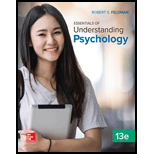
Introduction: The behavior that causes an individual to experience distress and hinders them from their daily life functioning is called abnormal behavior. The psychologists have struggled to form a clear, scientific definition of abnormal behavior because of the difficulty to differentiate normal behavior from abnormal behavior.
Answer to Problem 1E
Correct answer: The problem in defining abnormal behavior is that statistically rare behavior may not be abnormal, not all abnormalities are accompanied by feelings of discomfort, and cultural standards are too general to be used as a measuring tool.
Hence, the correct answer is option d.
Explanation of Solution
Reasons for the correct answer.
Option d. is given as “All of the above are correct”.
According to the definition of abnormality, the behavior that is rare in a society is considered abnormal and the abnormalities that are accompanied by feelings of discomfort in a person is considered abnormal if their cultural standards are different from what society considers ideal.
Hence, the correct answer is option d.
Reasons for the incorrect answers.
Option a. is given as “Statistically rare behavior may not be abnormal”.
According to the definition of abnormality, as a deviation from the average behavior, the behavior that is rare in a society is considered abnormal. This is one of the problems in defining abnormal behavior, but the other options are also correct.
Hence, option a. is incorrect.
Option b. is given as “Not all abnormalities are accompanied by feelings of discomfort”.
The abnormalities are accompanied by feelings of discomfort according to the definition of abnormality as a sense of personal discomfort. This is one of the problems in defining abnormal behavior, but the other options are also correct.
Hence, option b. is incorrect.
Option c. is given as “Cultural standards are too general to use as a measuring tool”.
According to one of the definitions of abnormality, as a deviation from ideal, a person is considered abnormal if their cultural standards are different from what society considers ideal. This is one of the problems in defining abnormal behavior, but the other options are also correct.
Hence, option c. is incorrect.
Hence, options a, b, and c are incorrect.
The behavior that is rare in a society is considered abnormal and a person is also considered abnormal if his cultural standards are different from what society thinks ideal. The abnormalities are accompanied by feelings of discomfort.
Want to see more full solutions like this?
Chapter 37 Solutions
Essentials of Understanding Psychology
- what makes the candomble tradition stand out?arrow_forwardby observing behavior students in class , what your thoughts about the effectiveness and purpose of the work being done there?arrow_forwardWhen would using checklists and rating scales be most appropriate in early childhood? Use scholarly sources.arrow_forward
- I need help with two articles are there any similarities and differences between the two https://www.phnompenhpost.com/business/indian-ambassador-pledges-increased-trade-tourismpromotion, https://time.com/5486460/pol-pot-cambodia-1979/arrow_forwardEvaluate the application of behaviourism and cognitive psychological perspectives to contemporary issues in psychology.arrow_forwardAnalyse the similarities and the differences between behaviourism and cogniperspectives in psychology.arrow_forward
- Describe behaviourism and cognitive psychological perspectives.arrow_forwardEvaluate the key assumptions of behaviourism and cognitive psychological perspectives.arrow_forwardable to help me with this for revision purposes and used reference in APA Required reading: • McKevitt, G. (2024, September 2). https://www.bbc.com/culture/article/20240829-the-life-changing-day-world-war-two-beganarrow_forward
 Ciccarelli: Psychology_5 (5th Edition)PsychologyISBN:9780134477961Author:Saundra K. Ciccarelli, J. Noland WhitePublisher:PEARSON
Ciccarelli: Psychology_5 (5th Edition)PsychologyISBN:9780134477961Author:Saundra K. Ciccarelli, J. Noland WhitePublisher:PEARSON Cognitive PsychologyPsychologyISBN:9781337408271Author:Goldstein, E. Bruce.Publisher:Cengage Learning,
Cognitive PsychologyPsychologyISBN:9781337408271Author:Goldstein, E. Bruce.Publisher:Cengage Learning, Introduction to Psychology: Gateways to Mind and ...PsychologyISBN:9781337565691Author:Dennis Coon, John O. Mitterer, Tanya S. MartiniPublisher:Cengage Learning
Introduction to Psychology: Gateways to Mind and ...PsychologyISBN:9781337565691Author:Dennis Coon, John O. Mitterer, Tanya S. MartiniPublisher:Cengage Learning Psychology in Your Life (Second Edition)PsychologyISBN:9780393265156Author:Sarah Grison, Michael GazzanigaPublisher:W. W. Norton & Company
Psychology in Your Life (Second Edition)PsychologyISBN:9780393265156Author:Sarah Grison, Michael GazzanigaPublisher:W. W. Norton & Company Cognitive Psychology: Connecting Mind, Research a...PsychologyISBN:9781285763880Author:E. Bruce GoldsteinPublisher:Cengage Learning
Cognitive Psychology: Connecting Mind, Research a...PsychologyISBN:9781285763880Author:E. Bruce GoldsteinPublisher:Cengage Learning Theories of Personality (MindTap Course List)PsychologyISBN:9781305652958Author:Duane P. Schultz, Sydney Ellen SchultzPublisher:Cengage Learning
Theories of Personality (MindTap Course List)PsychologyISBN:9781305652958Author:Duane P. Schultz, Sydney Ellen SchultzPublisher:Cengage Learning





